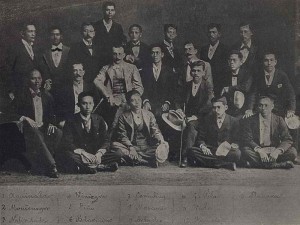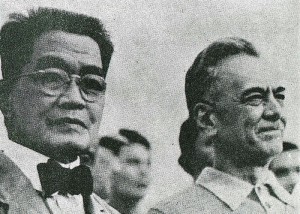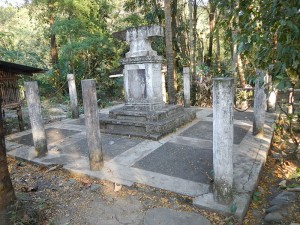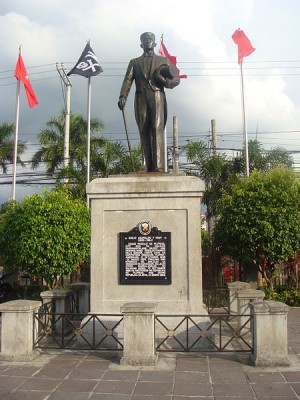| Emilio Aguinaldo | |
|---|---|
 |
|
| Filipino General | |
| In Power | 1894-1934 |
| Born | Mar. 23, 1869 Cavite El Viejo, Spanish East Indies (now Kawit, Cavite, Philippines) |
| Died | Feb. 6, 1964 Quezon City, Philippines |
| Nationality | Filipino |
| Political Party | Katipunan National Socialist Party |
Emilio Aguinaldo (1869-1964) was the first and youngest president of the Philippines. In addition to that, he was also a noted general who played a key role in the country’s revolt against its Spanish rulers as well as fighting against the occupation by the United States. His military abilities saw him featured heavily in the Philippine-American War that eventually led to the country’s independence. His time in power remains controversial as he was both a renowned freedom fighter and a dictatorial leader.
Early Life
Aguinaldo was born on March 22, 1868, in Cavite, the second-youngest of eight children. His family was wealthy and influential; his father held a mayoral post. The young boy was given a good education, but his father’s death in 1883 forced him to drop out of high school before he finished. From then onward, he was employed by his mother in running the family’s farms. He entered politics in January 1895, becoming “capitan municipal” in Cavite.
In 1894, Aguinaldo was inducted by fellow anti-colonialist Andres Bonifacio into the underground Katipunan movement. This organization was committed to the removal of Spanish colonialism, even if it meant accomplishing that goal by armed rebellion. They emerged into open rebellion in 1896, following the execution of vocal pro-independence activist Jose Rizal by the Spanish. Aguinaldo himself met and married Hilaria, his first wife, during this period.
Revolution in the Philippines
Unlike many of the other Katipunan rebels, Aguinaldo’s men had the ability to meet the colonial forces in pitched battle. As a result, they were able to repel them from Cavite. This, though, brought them into conflict with supporters of Bonifacio, who was by now the self-proclaimed president of the Republic of the Philippines. An election was held between the two factions in Tejeros in March 1897. Alguinado claimed victory, although there were suggestions of ballot fraud and Bonifacio rejected the result. Aguinaldo responded by having Bonifacio and his brother arrested. In May, they were executed for treason and sedition.
The Spanish took advantage of the breaking of Katipunan ranks to attack. In June, they recaptured Cavite, forcing the rebels back to the mountain stronghold of Biyak na Bato, northeast of Manila. Even so, by the end of 1897, Aguinaldo’s men were forced into a negotiated surrender, agreeing to exile in Hong Kong in exchange for indemnity, amnesty, and colonial reform. However, the Spaniards did not keep their side of the agreement. They arrested those still in the Philippines who were suspected of supporting the Katipunan. The rebels responded by restarting resistance activities.
The Spanish-American War
 In Cuba in February 1898, the USS Maine sank in Havana Harbor after an explosion. Public indignation, encouraged by rabble-rousing journalists, led to the United States going to war with Spain on April 25. Aguinaldo, seeing the opportunity to attack Spain, joined the U.S. Asian Squadron at the Battle of Manila Bay on May 1, which resulted in a heavy Spanish defeat.
In Cuba in February 1898, the USS Maine sank in Havana Harbor after an explosion. Public indignation, encouraged by rabble-rousing journalists, led to the United States going to war with Spain on April 25. Aguinaldo, seeing the opportunity to attack Spain, joined the U.S. Asian Squadron at the Battle of Manila Bay on May 1, which resulted in a heavy Spanish defeat.
Aguinaldo returned to his home country on May 19. Three weeks later, he declared himself president of a new, independent Philippines, as well as acting as the Filipino commander in battle. Over 10,000 U.S. troops cleared colonial forces from Spanish bases, including Manila. The end was reached on December 10 when the Treaty of Paris saw all Spanish colonies turned over to the U.S.
Aguinaldo as Filipino President
In January 1899, Aguinaldo saw his official inauguration as president of the Republic of the Philippines. He openly referred to himself as a dictator with the country’s new cabinet headed by Apolinario Mabini as prime minister. The United States, however, declined to recognize the new government. William McKinley, the U.S. president at the time, suggested that one reason for his country’s refusal was that the people of the Philippines needed to be “Christianized,” in spite of the fact that they were already mostly Roman Catholics.
In fact, behind the rebels’ backs, Spain agreed to a deal with the United States: The Americans would take control of the Philippines in return for a payment of $20 million. Despite repeated protestations to the contrary, the Philippine Republic would remain little more than a colony; only the identity of its ruling power would have changed. Rudyard Kipling greeted this new American colonialism with the poem “The White Man’s Burden,” in which he referred to Filipinos as “half-devil and half-child.”
Resisting the U.S. Occupiers
The Americans’ takeover of the Philippines provoked outrage. Aguinaldo responded by saying that Filipinos were now “disposed to open hostilities” against any U.S. troops that attempted to enforce their seizure of the country. He went on to denounce the United States in strong terms, saying that any blood which was shed as a result would be on the heads of the American occupying forces.
By the time men of the American Philippines Commission arrived in Manila in February 1899, there was a face-off between the 15,000 U.S. troops ensconced in the city and an almost equal number of rebels positioned around it. This state of affairs persisted for some months. By November it had become clear that the Americans’ strength was too much, so the Filipinos headed back to the mountains with the intention of employing guerrilla tactics.
The next two years saw Aguinaldo’s dwindling forces continually escaping American pursuit. But in March 1901, he was captured at Palanan when the American Special Forces broke into his camp under the guise of being prisoners of war. Aguinaldo now had no choice but to surrender and swear loyalty to the U.S., which he did on April 1. He was then allowed to go into retirement back on the family farm in Cavite.
World War II and After
Aguinaldo married again in 1930 after the death of his first wife, but remained largely absent from public life. During World War II, Japan invaded the Philippines in December 1941 and Aguinaldo decided to cooperate with the Japanese and take part in the puppet government the invaders had set up. He became known for his speeches urging Filipinos not to resist the occupation. After the liberation of the country in 1945, this led to Aguinaldo being imprisoned for collaboration, although he was soon pardoned with his reputation mostly intact.
In 1950, he served one term on the Council of State under President Quirino, followed by some time working with veterans. In 1962, Aguinaldo’s public rehabilitation was complete as President Macapagal announced that Independence Day would now be celebrated on June 12, the anniversary of the day the First Philippine Republic had been declared. Aguinaldo himself, now 92 years of age, was in attendance. He died of thrombosis on February 6, 1964.


